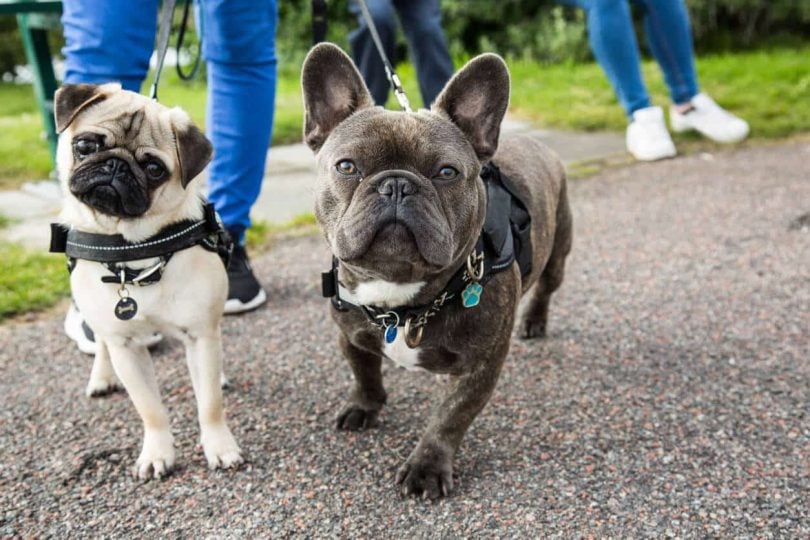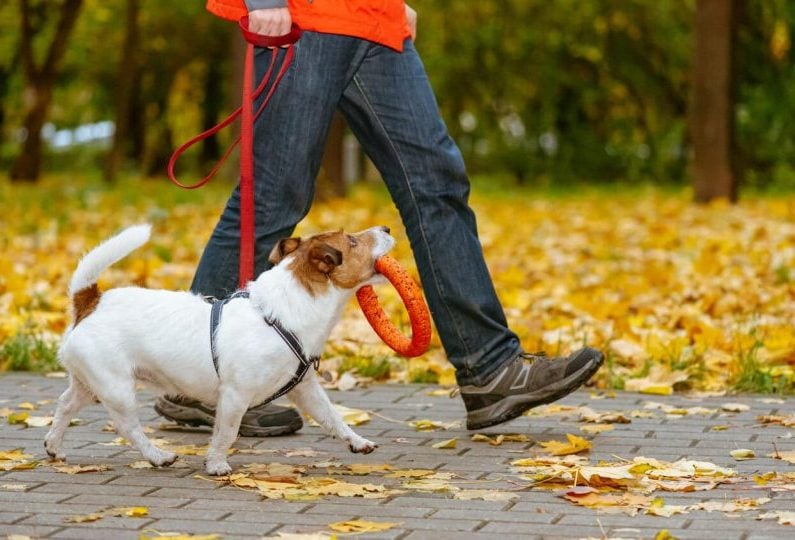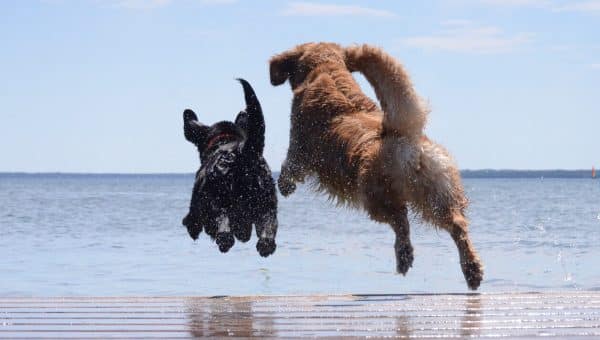- This post contains affiliate links. Read more here.
- Not a substitute for professional veterinary help.
While you probably know your dog needs regular exercise, you may feel less sure about how often you actually need to walk them. Big or small, puppy or senior, all dogs need walks and other mentally stimulating exercises to stay in shape.
In general, the daily walk for the average dog may be anywhere from 5 to 30 minutes, up to twice a day, while more active dogs may need up to one hour or two. Keep in mind, however, that the quality of the walk can be much more effective than the quantity or length of the walk.
And where your dog falls in the 5 to 30 minute range depends on their age, breed, and health. This means a senior dog with arthritis may only be able to physically handle a five minute walk, twice a day. Adult dogs will more likely need 30 minutes to two hours of play or walking. Working adult dogs, on the other hand, may need a training session during a one-hour walk to keep their brain stimulated. (P.s. If you notice your dogs still acting out of boredom after a walk, try adding enrichment games or toys into your routine.)
We consulted Nicole Ellis, Certified Professional Dog Trainer, to learn more about the factors that might play a role in your dog’s walks—plus, why walking can be great for both you and your dog and how to meet your dog’s specific needs.
How to Adjust Your Dog’s Walking Routine
Beyond general bathroom needs, there’s no perfect formula to determine how long a dog’s walk should be. A gentle 30-minute walk is often a good starting point for dogs and humans alike, especially if you or your dog are just getting used to regular exercise. From there, you can gradually take longer walks by adding 15 minutes or a second walk in the day. Limiting your walks on extremely hot or cold days can also help keep your dog safe and healthy.
Signs your dog needs more or longer walks:
- Your vet recommends they lose some weight
- Increase in destructive behavior, like chewing or shredding furniture and other household items
- Excess energy or inability to settle after walks
- Indoor urination, without a medical cause
Signs your dog needs shorter walks or alternative exercise:
- Uneven gait
- Stiff movements, which may suggest soreness
- Lethargy, or a lack of energy
- Reactivity or signs of stress when outside
There’s a difference between tiredness after an unusually long hike, which is perfectly normal, and consistent tiredness. If your dog seems tired every day, you may want to ease up on their walks and see a vet to make sure there’s nothing else going on. A veterinarian can also offer more guidance on a good amount of exercise for your dog.
Pro Tip: Letting your dog determine and sniff to their heart’s content is also known as a decompression walk. This type of walking can sometimes be healthier for tiring your pup out than an intense and long stroll. Sniffing can help decrease a dog’s anxiety and stress.
Puppy Walking Guidelines: Time, Growth Factors & More
Adult dogs and puppies have different walking needs. “A good rule of thumb is five minutes of exercise per month of age, twice a day or so,” Ellis says, and then you can build from there as your puppy grows older. Just keep in mind that puppy walks are separate from puppy potty breaks!
Always let your puppy choose the gait and distance that’s comfortable for them to avoid pushing them beyond their limits. According to Ellis, letting your puppy determine how far and fast you go is especially vital because their growth plates have yet to close, which means there’s still space between their bones.
Too much or too strenuous exercise can lead to injury, especially in large-breed dogs.
Do Potty Breaks Count as Exercise?
You might wonder if your dog really needs more than one walk per day. Can a quick potty romp around the yard take the place of a second walk?
That depends on your dog, but many dogs tend to enjoy longer walks because it gives them a chance to explore the world. Plus, dogs need to do their business several times a day—at least three to five times, as a general rule. So, if you don’t have a yard, you’ll want to leash up every four to six hours (more often for puppies or senior dogs).
Longer walks also keep your dog mentally healthy, as some dogs become anxious or destructive when they don’t get enough physical activity. “Is he chewing on things, urinating in the house, or destroying the furniture? That could be both a lack of mental or physical exercise and enrichment,” Ellis says.
In short, indoor accidents don’t just mean your dog probably needs more bathroom trips. They can also point to a lack of stimulation. So, dog walks that extend beyond a quick potty break can benefit you as well as your dog.
What Is the Best Time to Walk a Dog
Trying to figure out when to walk your dog? That depends, too. Some dogs may prefer to head out as soon as you get up, while others may be willing to wait until you’ve showered and had some breakfast. Keep in mind, too, that some dogs may need a bathroom break, at the very least, shortly after eating.
The most important thing is to keep your dog on a schedule, since dogs thrive on routine. Ellis also emphasizes that your environment can matter here, too. If you live in a hot climate, you may want to aim for an early morning or evening walk, when the heat is less intense.
“I generally like to do a walk in the morning, and then maybe a nice long one at night before we go to bed and settle down. That gives them a nice time to relax and decompress from the day,” Ellis says.
But if your dog is reactive on walks—for instance, if they bark and lunge at other dogs—walking when your neighborhood is quieter can help you both enjoy a better walk, according to Ellis. After all, if walking your dog stresses you out, you may feel a lot less like doing it.
On the other hand, if your dog is super social or you’re trying to socialize your puppy, pick times when your neighborhood or dog park is more bustling.
Looking for just the right walking accessories?
Ellis recommends the following gear, which she uses with her dogs on their walks:
- Collar with ID tags: Even fully trained dogs can get loose, so make sure they’re wearing a tag with your contact information at all times. Don’t forget their rabies vaccination tag, either!
- Reflective gear for night and low-light walks: You can attach a light to your dog’s collar or buy a vest or collar with reflective details to help ensure a safe walk at night or on darker days.
- A Y-shaped harness: These styles have a leash attachment in the front. This helps limit pulling without restricting your dog’s shoulder movement.
- Running gear: If you plan to take your adult dog on runs, you may want to consider special gear, like a hands-free leash or dog running boots.
What to Do When You Can’t Go Outside
If you’re short on time, dealing with bad weather, or your dog has more energy than you do, you have options beyond walking to help them burn off some mental and physical energy with indoor activities.
Ellis recommends the following:
- Walking your dog with their harness and leash inside the house. This offers the opportunity to practice training and heeling while also incorporating movement.
- Try puzzle toys, treat balls, and Kongs for mental enrichment.
- Set up an agility course in your home. For instance, you could use household items like boxes, couch cushions, or buckets as obstacles.
- Sign up for online classes or watch videos to learn new tricks you can teach you dog.
And of course, you can always call on a Rover walker or daycare provider to help your dog get their daily exercise.
Which Breeds Need Walks More Often?
All dogs are unique, which means not all dogs may love fetch—or walking. Some dogs may require breed-specific exercise routines or games.
These working or high-energy dog breeds need more mental and physical stimulation and may benefit from more frequent exercise:
- Terriers
- Border Collies and other herding breeds
- Australian Shepherds
- German Shepherds
- Labrador Retrievers
- Golden Retrievers
On the other hand, these less-active dog breeds may be fine with just one or two shorter walks per day:
7 Benefits of Walking Your Dog Often
Walks help keep your dog healthy in several ways:
- Weight control: Regular exercise helps your dog burn extra calories and maintain a healthy weight.
- Joint health: Have you ever had stiff legs after sitting for a long time? Your dog has similar joints, so regular motion can help them stay comfortable and in good shape.
- Digestive and urinary health: Holding in urine and bowel movements isn’t good for anyone, person or dog. Regular walks help keep your dog, well, regular. And all that peeing around the neighborhood doesn’t just support their urinary health. It also lets them communicate with other dogs.
- Stress relief: Moving and engaging with the environment outside of the home can also help your dog release pent-up nervous energy after an ordeal, like a long car ride, trip to the vet, or grooming visit.
- Training opportunities: A walk is an excellent time for your dog to practice skills they’re learning, like “Heel,” “Wait,” “Sit,” and of course, the all-important “Leave it.”
- Mental stimulation: Sniffing is mentally enriching and rewarding for dogs. It also gives them the opportunity to learn about their surroundings. Plus, walks offer the chance to play stimulating games with your puppy.
- Socialization: Dogs are social creatures, and walks give them a chance to see their friends and make new ones.
Regular walks can help boost your dog’s mental and physical health, and they can provide those same benefits for you. Just make sure to consider your dog’s age, activity level, health, and breed. Younger adult dogs with more energy often need more frequent walks. On the other hand, senior dogs, dogs with ailments or disabilities, and very young puppies do fine with fewer or shorter walks.
In short, dog walking is a necessary part of pet parenthood, but it’s also a fun and engaging way to relax and bond with your dog.







